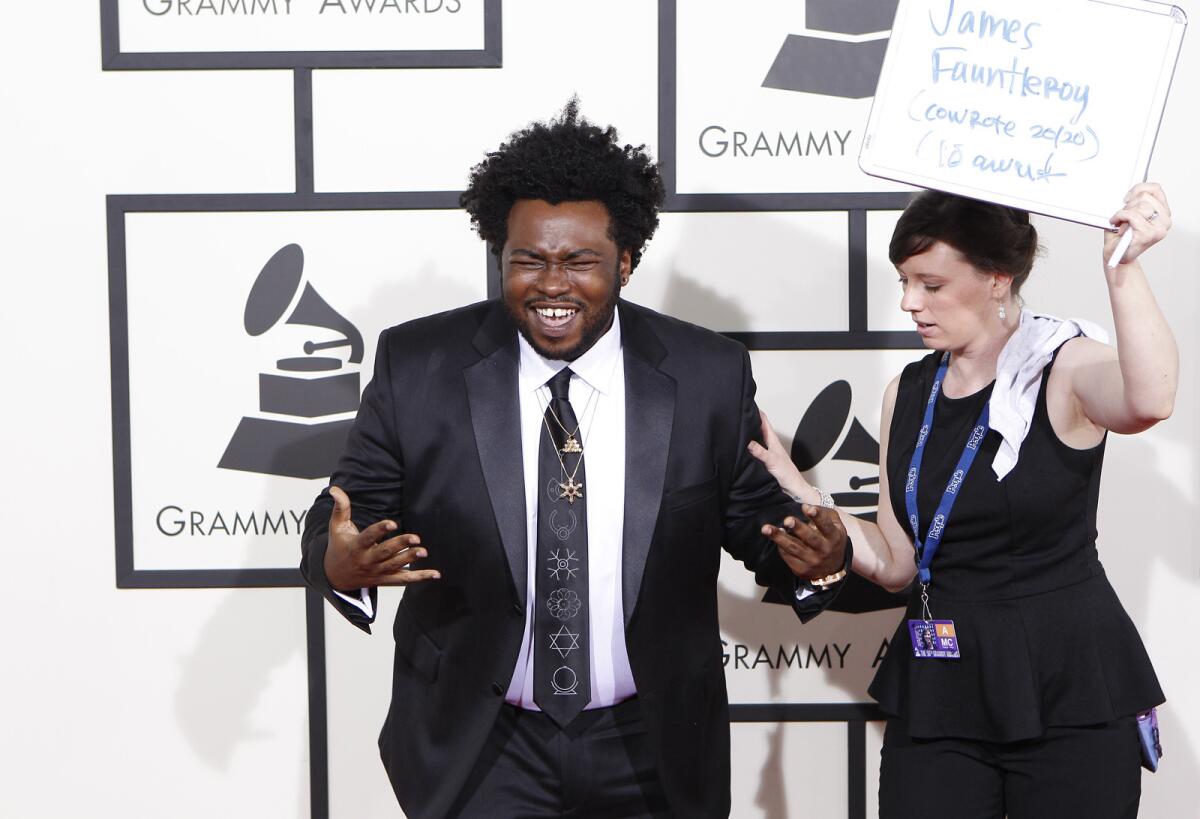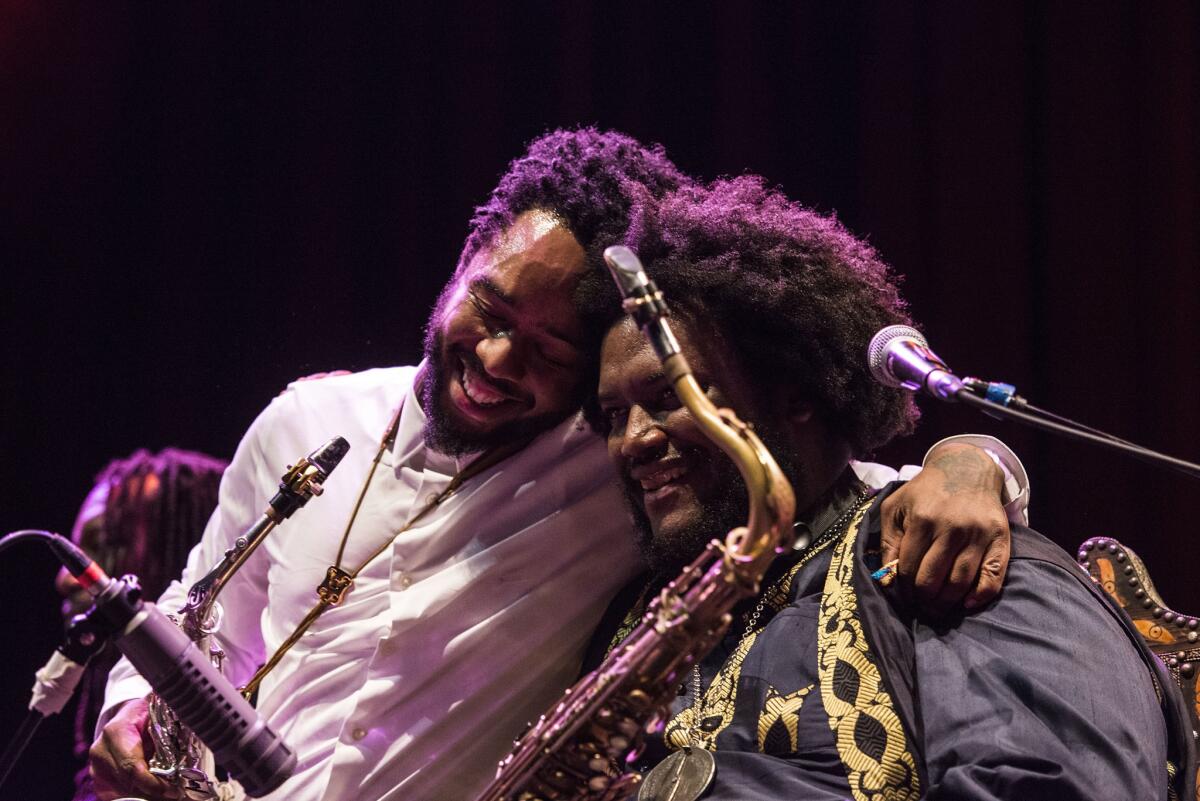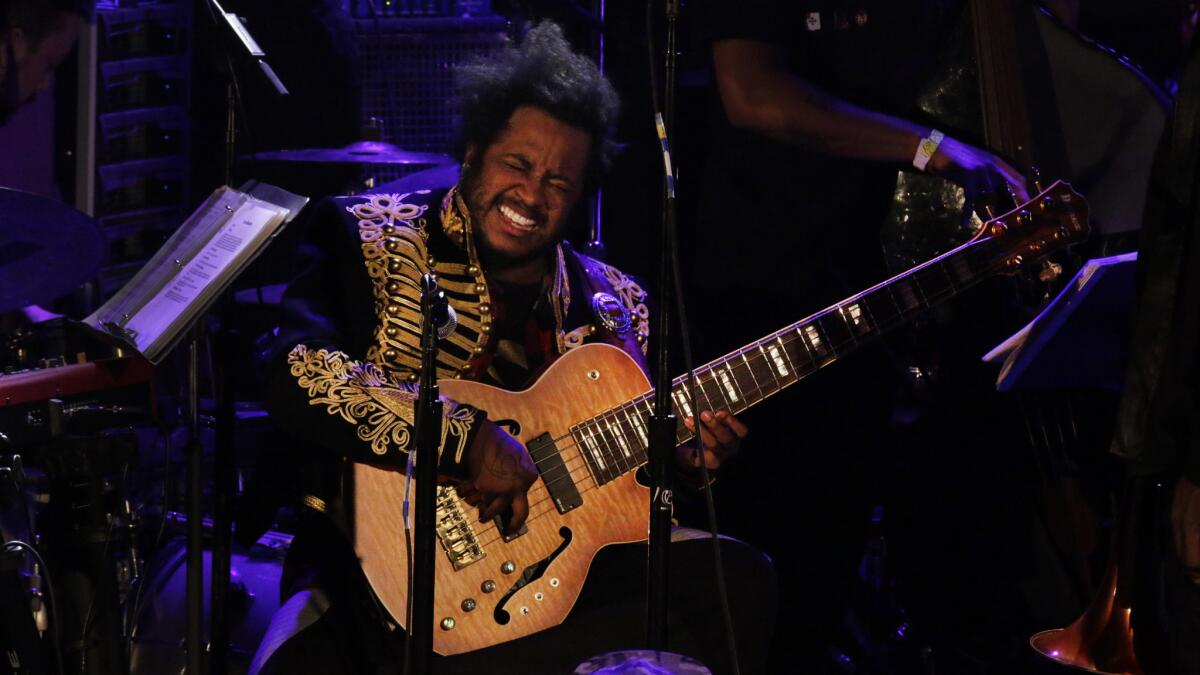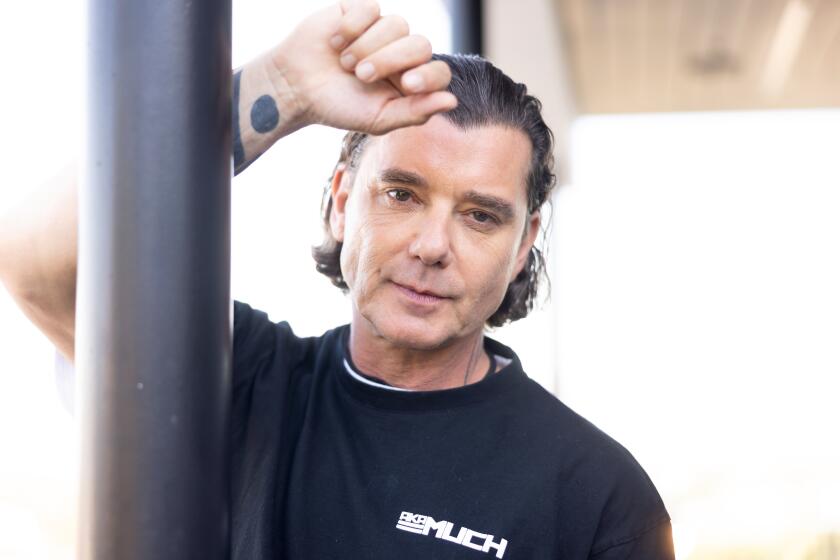10 essential artists who helped Kendrick Lamar shape his Grammy-nominated ‘To Pimp a Butterfly’

Kendrick Lamar performs at the Wiltern Theatre in Los Angeles on Nov. 11, 2015.
- Share via
When Kendrick Lamar arrives at the Grammy Awards to accept applause for his album of the year-nominated “To Pimp a Butterfly,” the Compton-born rapper, lyricist and producer will be representing not only himself and his city: He’ll also be carrying a community’s worth of creators who contributed to his platinum-selling album.
The “To Pimp a Butterfly” production credits illustrate its communal spirit. Unlike the scant four credited contributors on fellow nominees “Traveller” by Chris Stapleton and the Alabama Shakes’ “Sound and Color,” “To Pimp a Butterfly” lists nearly three dozen collaborators. The album features just as many acoustic musicians playing strings, woodwind, brass, keyboards and percussion. A choir’s worth of vocalists add human texture throughout.
FULL COVERAGE: Grammys 2016
It’s those resonant tones coupled with Lamar’s phrasing and lyricism that have drawn both critical kudos and commercial success. Even President Obama praised “To Pimp a Butterfly” and the artist, going so far as to host him at the White House. To top it off, Lamar is nominated for 11 Grammys, seven of them for music from “To Pimp a Butterfly.” In addition to the album of the year and rap album nominations, Lamar’s incendiary “Alright” is up for song of the year, rap song, rap performance and music video.
Below are a number of the essential musicians, many either born or based in Southern California, who worked on Lamar’s landmark studio album.

James Fauntleroy at the 56th Grammy Awards.
James Fauntleroy. With a regal name that suggests British aristocracy, the Inglewood-born artist has helped write hits for Rihanna (six songs from “Rated R”), Justin Timberlake (“Pusher Love Girl”), Jordin Sparks (“No Air”) and Chris Brown (“Superhuman”). On “To Pimp a Butterfly,” Fauntleroy helped write and sing “How Much a Dollar Cost.”

L.A. producer Flying Lotus
Flying Lotus. A Grammy nominee himself in the dance recording category, the Los Angeles beat producer served as a prime connector on “To Pimp a Butterfly.” The artist, born Steven Ellison, not only produced the album’s tone-setting first track but helped connect Lamar with contributors Thundercat and Kamasi Washington. Most notable, though, is the uncredited Lotus influence that informs much of “To Pimp a Butterfly.” A strong undercurrent of his productions over the past decade mixing beat music and cosmic jazz permeates the album.
See the most-read stories in Entertainment this hour >>
Robert Glasper. The Texas-born, New York-trained jazz pianist plays on a number of the 16 tracks on “To Pimp a Butterfly.” The artist, whose work with his trio as well as the R&B-tilted Robert Glasper Experiment has earned him a devoted following, plays keyboards on Lamar’s tracks “The Blacker the Berry,” “Complexion (A Zulu Love)” and “These Walls,” among others.

Lalah Hathaway at the 57th Grammy Awards.
Lalah Hathaway. The fellow Grammy nominee has been on a roll. At last year’s Grammys Hathaway and collaborators Glasper and Malcolm-Jamal Warner won a traditional R&B performance trophy for the song “Jesus Children.” This year Hathaway, the daughter of soul singer Donny Hathaway, is nominated again in the category for her song “Little Ghetto Boy.” On “Butterfly,” her ethereal voice is the centerpiece of the smooth jazz breakdown that concludes “The Blacker the Berry.”

Terrace Martin, left, and Kamasi Washington pitched in on “To Pimp a Butterfly.”
Terrace Martin. By the time he was in his teens, the prodigal multi-instrumentalist had won the respect of jazz masters and at least one late-night talk show host. Martin earned a scholarship and his first professional horn from Jay Leno, and before graduating high school Martin had already played with Snoop Dogg and Puff Daddy. A decade later Martin is all over “To Pimp a Butterfly,” punctuating tracks with his primary instrument, saxophone, while also chiming in with keyboards and beats.
Sounwave. As a member of the Digi+Phonics production team (with Taebeast, Dave Free and Willie B), producer Mark “Sounwave” Spears has helped track hits by fellow Top Dawg signees Schoolboy Q, Isaiah Rashad, SZA, Jay Rock and Ab-Soul. Each possesses deep Los Angeles knowledge, but Sounwave’s tracks stand out on “To Pimp a Butterfly.” “King Kunta,” for example, is built around the producer’s reworking of the beat from “Get Nekkid” by the late Compton rapper Mausberg, who in 2000 was killed during a robbery at age 21. Like Sounwave’s best known co-production, for Lamar’s “Bitch Don’t Kill My Vibe,” “King Kunta” has quickly become a Los Angeles anthem.
SZA. The lone female among the Top Dawg Entertainment’s current roster, the St. Louis-born vocalist offers a necessary counterpoint on a few “Butterfly” tracks. Best known of late for her contributions on “Consideration,” from Rihanna’s new album, “Anti,” SZA has been working on her own full-length debut for the past few years. In the interim, the artist born Solana Rowe has helped co-write hits for Nicki Minaj and Travis Scott.

L.A. bassist and producer Stephen “Thundercat” Bruner.
Thundercat. If you listen close enough, L.A. bassist and producer Stephen “Thundercat” Bruner’s robo-funk lines are probably rumbling in somewhere outside your window right now. The ubiquitous artist’s fingerprints are all over the new sound of the city. In addition to his excellent solo work across albums and EPs, the charismatic bassist has collaborated with beat producer Flying Lotus, jazz bandleader and composer Kamasi Washington and hardcore punk band Suicidal Tendencies.
Kamasi Washington. Although saxophonist Martin occupies much of the horn space on “To Pimp a Butterfly,” his Los Angeles peer Washington makes his mark during “U.” The free-form cosmic jazz jam gathers the two players, both graduates of Roosevelt High School, for a sax duet as Lamar throws a verbal tantrum. Washington, who also helped arrange the strings throughout “Butterfly,” had his own breakout year. His three-disc debut album “The Epic” (released on Flying Lotus’ Brainfeeder label) upended the contemporary jazz world, helping to direct its focus on the energy burning on the West Coast.
Anna Wise. Long a secret weapon on underground Los Angeles beat projects, the artist has added her voice to work by Low End Theory-linked producers including Nobody, Teebs and MNDSGN. As half of the duo Sonnymoon, Wise has issued tracks on the respected local label Plug Research. Her credits on five “To Pimp a Butterfly” songs will likely further her ascent. That’s especially true of that strange hook on “Institutionalized,” in which she and vocalist Bilal sing, “If I was the president/ I’d pay my mama’s rent/ Free my homies and them/ Bulletproof my Chevy doors.”
Twitter:@LilEdit
More to Read
The biggest entertainment stories
Get our big stories about Hollywood, film, television, music, arts, culture and more right in your inbox as soon as they publish.
You may occasionally receive promotional content from the Los Angeles Times.











